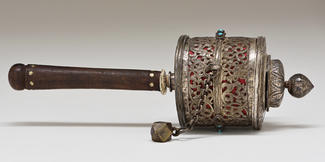
Isabella Gardner bought a prayer wheel at a bazaar in Darjeeling where Bhutanese, Tibetans, and Lepdras came to sell goods. The following day, January 28, 1884, she saw worshippers at a Tibetan monastery walking around a pagoda using prayer wheels. These devices were only slowly becoming known in the West as a component of Tibetan Buddhist practice. With each movement of the wrist and turn of the wheel, a prayer or mantra (written numerous times on a roll of paper enclosed by a red cloth and the silver cylinder) is disseminated in the air, conferring religious merit on the bearer. The movement is fueled by a copper ball-and-chain governor connected to the center of the silver cylinder.
Hand prayer wheels (and similar devices driven by water, air, and even modern technologies) are used by Tibetans of all classes, and are called mani (jewel) wheels because they are associated with the Bodhisattva of Compassion, Avalokiteshvara, and his Six Syllables Mantra, “om mani padme hum,” which can be translated as “hail the jewel-lotus” or “hail to the jewel in the lotus.”1 This is also the mantra written in Tibetan on the roll enclosed in Isabella Gardner’s wheel.
Twelve turquoises (one is now missing), arranged in four groups, decorate a band that separates two openwork sections of the cylinder. Among the leafy decorations are the eight auspicious Buddhist symbols: in the upper band are the parasol, endless knot, canopy, and conch; in the lower band are the wheel, treasure vase, lotus flower, and golden fishes. The carved wooden handle is inlaid with small pieces of shell.
1 From the Sacred Realm: Treasures of Tibetan Art from the Newark Museum. Exh. cat. Newark Museum, 1999-2000. By Valrae Reynolds et al.: 55–56. For a different interpretation, see Dan Martin, "On the origin and significance of the prayer wheel according to two nineteenth-century Tibetan literary sources," Journal of the Tibet Society 7 (1987): 13-29.
Source: Pedro Moura Carvalho, “Jewelry and Objects from India,” in Journeys East: Isabella Stewart Gardner and Asia, edited by Alan Chong and Noriko Murai (Boston: ISGM and Gutenberg Periscope, 2009): 462-63.